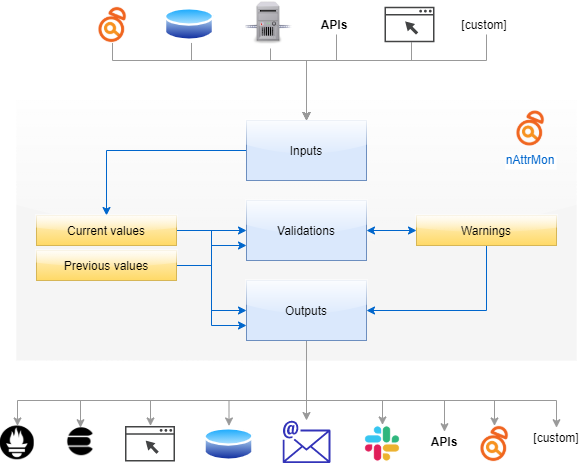Introduction
nAttrMon (n-Attribute-Monitor) is basically a small open source generic monitoring tool, using OpenAF. It’s extensible through plugs (small editable files) divided into three categories: inputs, outputs and validations:
- The inputs are responsible to gather unique attribute values.
- The validations are responsible to analyze the attribute values and generate warnings and/or perform actions (e.g. self-healing).
- The outputs are responsible to make attribute values and warnings available (e.g. HTTP, Email, Notification, etc…).
(the source code is available in GitHub)
Install
To install nAttrMon you will need to first install OpenAF and then simply execute:
opack install nattrmon
This will install a nAttrMon opack folder on your OpenAF installation. Check the following topics for more details regarding the folder structure and base configuration:
Afterwards you will need to add some input, output and validation plugs covered below under “Adding plugs”. Then you can start by executing:
oaf -f nattrmon.js
Alternatively you can create a start script be executing:
opack script nattrmon
Get the latest and previous releases
All latest and previous releases can be checked in GitHub nAttrMon releases.
Source
You can also checkout all the sources on GitHub.
Architecture

Inputs, Outputs and Validations
The inputs, outputs plugs are loaded (by alphanumeric order from their corresponding folder) upon nAttrMon start and run in parallel on specific time intervals, internal cron schedule or triggered by changes (e.g. changes on attribute values, creation/update/close of warnings, etc…). These plugs can inherit most of their functionality from available existing objects (to promote reusability) or be totally customized.
Attribute values and Warnings
At all times plugs have access to the current warnings, current atribute values and previous attribute values that are stored in memory either by time or by the last different value. These values can be simple types (e.g. strings, numbers, booleans, …) or maps/arrays. nAttrMon keeps track of when an attribute was last checked and when it’s value last changed.
Operating and accessing other systems
nAttrMon is designed to be “killed” and restarted whenever needed so all relevant memory information is persisted automatically in snapshot files.
Available to plugs are also object pools to globally manage access to databases, application servers, ssh connections, etc. These object pools are accessed by keys (either static or dynamic) that can have associations between them (e.g. application server A (key “APP1”) is associated with database server connection B (key “DAT1”)). Since the list of keys and corresponding object pools can be dynamic, plugs can automatically adapt to changes in sources (e.g., adding/removing application servers, adding/removing database connections, adding/removing docker containers).
Using it
Start by understanding:
- The folder structure
- Examples of adding Inputs, Outputs or Validations
- The generic plugs parameters available
- Existing base Inputs, Outputs or Validations (also known as objects)
- Running as single mode
